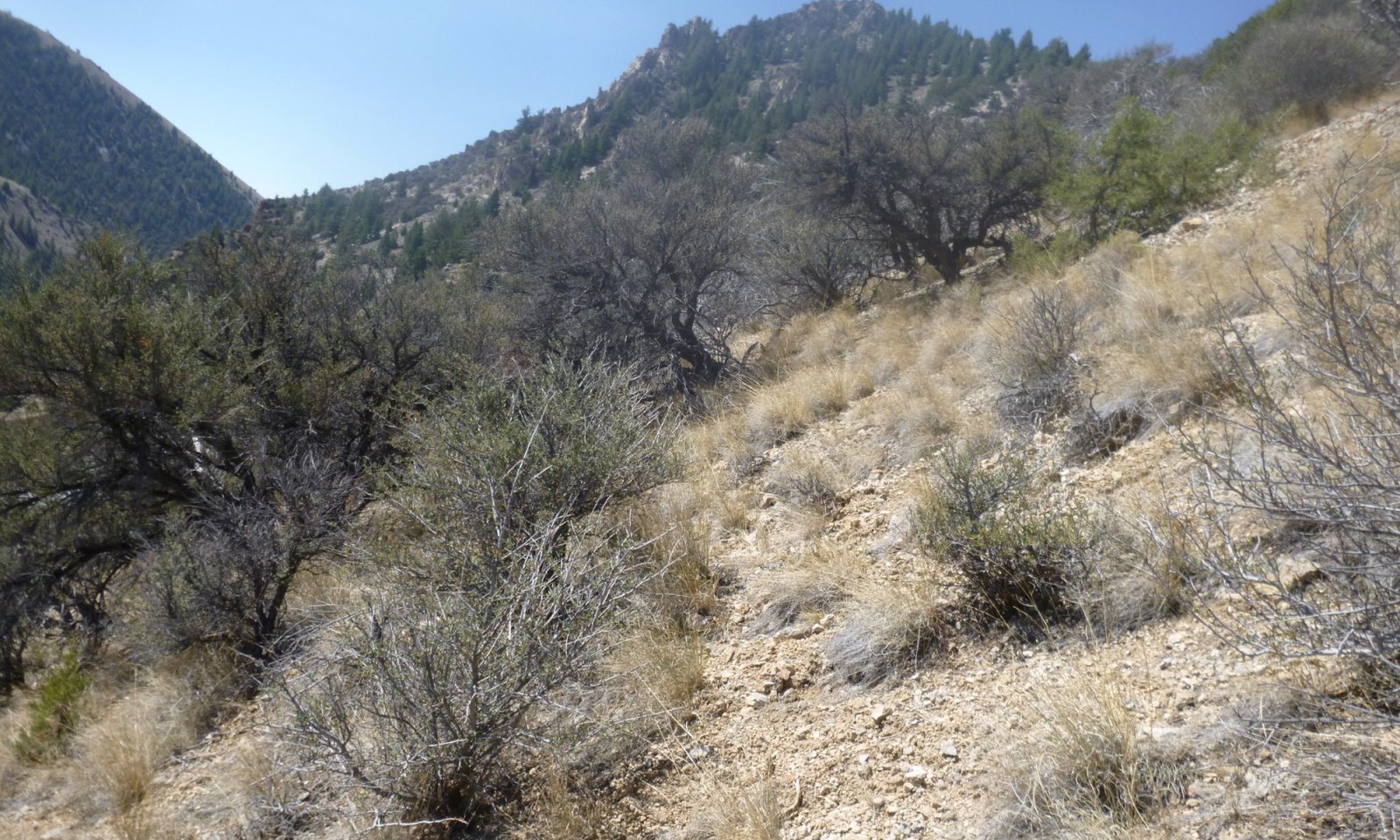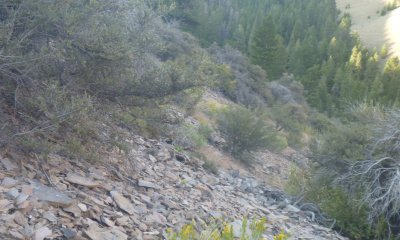
Rocky Hills 10-14 Inch Precipitation Zone Lost River Mountains
Scenario model
Current ecosystem state
Select a state
Management practices/drivers
Select a transition or restoration pathway
- Transition T1-2 More details
- Transition T1-3 More details
- Restoration pathway R2-1 More details
- Transition T2-3 More details
-
Restoration pathway R3-1
Restoration efforts can be greatly influenced by precipitation patterns. Successful regeneration of Reference state understory species is highly dependent on moisture received post-restoration efforts. Rates of successful establishment of bluebunch wheatgrass and Sandberg bluegrass increase when available moisture is high during critical regeneration periods (Zlatnik, 1999 & Howard, 1997).
More details -
No transition or restoration pathway between the selected states has been described
Target ecosystem state
Select a state
Description
The Reference state consists of three dominant plant communities: The curl-leaf mountain mahogany and black sagebrush (Artemisia nova) dominated community, the mixed shrub overstory community (1.2) which can include curl-leaf mountain mahogany, mountain big sagebrush (Artemisia tridentata ssp. vaseyana), low sagebrush (Artemisia arbuscula) and black sagebrush (Artemisia nova), and the wooded mountain mahogany community which can include Douglas fir (Pseudotsuga menziesii), Rocky Mountain juniper (Juniperus scopularum), and limber pine (Pinus flexus). The understory in both communities is dominated by bluebunch wheatgrass but can include a variety of other bunch and rhizomatous grasses at a lesser canopy cover. The primary difference between the two communities is the composition and foliar cover of shrub species. Foliar cover of other shrub species increases in relation to openings not already occupied by curl-leaf mountain mahogany.
Processes (both natural and anthropogenic) that result in state and community changes include fire, grazing, land use change, and the occurrence of invasive species.
Characteristics and indicators
The shift between communities in the Reference state is driven by curl-leaf mountain mahogany canopy cover. Well-established stands of mountain mahogany can be dense and prevent any future establishment of other shrub species, primarily sagebrush. Likewise, less dense canopies of mountain mahogany present less competition and create opportunities for other species to establish in their absence.
Low-severity disturbances are the primary driver for decreasing the canopy cover of mountain mahogany and creating opportunities for other species to establish. Severe disturbances such as fires that are stand-replacing and destroy the seed bank could lead to a shrub community not dominated by curl-leaf mountain mahogany.
Resilience management
The Reference state is overall moderately resilient. In well-established communities, resilience towards climatic disturbances such as drought is high. Curl-leaf mountain mahogany is adapted to dry conditions and is able to take advantage of moisture funneled to cracks in the bedrock. Resilience to low-severity fire is high; however, severe stand-replacing fire, which removes any nearby seed source, can take several decades to recover from (Gucker, 2006).
Submodel
Description
This community shifts from the shrub-dominated communities of the Reference State to a community dominated by native bunchgrass and disturbance-tolerant species. The grass species tend to be similar to that of the reference communities and include bluebunch wheatgrass, Sandberg bluegrass, and Indian ricegrass. The overstory shrub community, if present, is yellow rabbitbrush and to a lesser extent, threetip sagebrush.
Production for this community is no longer weighted toward the shrub functional group, but shifts towards grasses and forbs. Production values remain relatively high, ranging from 500 to 900 pounds per acre, averaging 650 pounds per acre.
Characteristics and indicators
The Disturbed state in the Rocky Hills ecological site results from any disturbance that removes the overstory vegetation. The primary disturbance for this ecological site that results in the removal of overstory shrubs is frequent or severe fire. The dominant overstory species found in the Reference state such as curl-leaf mountain mahogany, black sagebrush, low sagebrush, and mountain big sagebrush experience high rates of mortality during severe fire events. In the immediate years following the event, canopy cover increases for early seral and disturbance-tolerant species such as yellow rabbitbrush (Chrysothamnus viscidiflorus), three-tip sagebrush (Artemisia tripartita), and the common bunchgrass species found in most communities of the Reference state.
Historic fire return intervals for curl-leaf mountain mahogany stands in the Salmon River area ranged between 13 to 22 years. Because of grazing and fire exclusion, the time between fire events has increased significantly. This has resulted in fewer, but more severe stand-destroying fire events (Gucker, 2006).
Resilience management
Once in the Disturbed state, resilience is moderately high. The species present are disturbance tolerant or even perpetuated by frequent or continued disturbance events. Resilience is lost, however, by the opportunity for invasive species establishment. Openings in the canopy caused by a disturbance can allow for the recruitment of invasive species if native species don't readily occupy those spaces.
Submodel
Description
The Invaded State is represented by a shift from native grasses and forbs in the understory to an understory dominated by invasive species. Transition to this state occurs after a severe disturbance that creates openings in the canopy for invasive species to establish. The primary invasive species that becomes dominant in the Invaded State is cheatgrass (Bromus tectorum). This state is especially prevalent on steep, rocky slopes where colluvial movement is active. As the soil is disturbed through movement of material downhill, ideal conditions are presented for cheatgrass recruitment. Once established and a seed source is readily available, cheatgrass is well adapted to increasing its coverage area.
Characteristics and indicators
This state is indicated by any single invasive species occupying five percent or more of the canopy, or a group of invasive species occupying 10 percent of the canopy collectively.
Resilience management
This state exhibits low resilience due to the establishment of invasive and non-native species. Once established, non-native vegetation tends to increase in canopy cover and can often be promoted by further disturbances.
Submodel
Mechanism
The transition from the Reference state to the Disturbed state is a mechanism of frequent or severe disturbances that remove the overstory shrubs on a given site. The most common disturbance that results in the loss of the shrub overstory is high-intensity fire. Historic fire return intervals for curl leaf mountain mahogany stands were relatively frequent (13 to 22 years) and events tended to be lower severity. Since 1900, fire exclusion has decreased fire return intervals and increased the likelihood of less frequent, more severe fire events that are often stand-destroying (Gucker, 2006).
Constraints to recovery
Constraints to recovery include: Frequent disturbances before recovery has completed; Prolonged periods of drought that diminish regeneration of desired species; Loss of nutrient-rich topsoil due to increased erosion; Establishment of invasive species; Distance from a seed source.
Context dependence
The primary factor driving the likelihood of restoration success is post-disturbance weather patterns. Prolonged periods of drought can slow restoration processes, whereas average to above-average precipitation post-disturbance can greatly increase speed and success in the re-establishment of Reference state species (Steinberg, 2002 and Fryer, 2009).
Mechanism
The transition from the Reference state to the Invaded state is result of disturbances that create opportunities for invasive species establishment. One of the primary disturbances resulting in invasion on this site is colluvial disturbances resulting from steep slopes. Soil movement downslope that disturbs the surface creates ideal conditions for the establishment of invasive species, one of the most prominent species being cheatgrass. Once locally established, cheatgrass is able to further spread across a site.
Constraints to recovery
Constraints to recovery include: The establishment speed of invasive species; Prolonged periods of drought that diminish regeneration of desired species; Loss of nutrient-rich topsoil due to increased erosion; Continued establishment and spread of invasive species.
Context dependence
Restoration success is dependent on invasive species composition and level of establishment. Removal of cheatgrass once significant establishment occurs can be resource intensive with low success rates.
Mechanism
Restoration from the Disturbed state to the Reference state is a mechanism of time without stand-destroying disturbance. Once the shrub overstory has been removed, replacement seedlings will need to reach maturity without any further disturbances.
Context dependence
The time frame for restoration is highly dependent on variations in localized weather patterns. Prolonged periods of drought can dramatically increase the time required to return to the Reference state, whereas periods of above-normal precipitation can decrease that time frame.
Distance from a seed source of Reference state Plants can impact restoration timeframes in the absence of seeding or planting.
Mechanism
The transition from the Disturbed state to the Invaded state results when a disturbance removes native vegetation cover and is replaced by non-native or invasive species. If native vegetation is not able to repopulate a site after a disturbance occurs, opportunities exist for the recruitment of invasive species in their absence. The most common invasive species to cause this transition at the Rocky Hills ecological site is cheatgrass.
Constraints to recovery
Constraints to recovery include: Grazing following a disturbance; Prolonged periods of drought that diminish regeneration of desired species; Loss of nutrient-rich topsoil due to increased erosion; Establishment of invasive species.
Context dependence
Restoration efforts can be greatly influenced by precipitation patterns. Successful regeneration of Reference state understory species is highly dependent on moisture received post-restoration efforts. Rates of successful establishment of bluebunch wheatgrass and Sandberg bluegrass increase when available moisture is high during critical regeneration periods (Zlatnik, 1999 & Howard, 1997).
Mechanism
The transition from the Disturbed state to the Invaded state results when a disturbance removes native vegetation cover and is replaced by non-native or invasive species. If native vegetation is not able to repopulate a site after a disturbance occurs, opportunities exist for the recruitment of invasive species in their absence. The most common invasive species to cause this transition at the Rocky Hills ecological site is cheatgrass.
Context dependence
Constraints to recovery include: Grazing following a disturbance; Prolonged periods of drought that diminish regeneration of desired species; Loss of nutrient-rich topsoil due to increased erosion; Establishment of invasive species.
Model keys
Briefcase
Add ecological sites and Major Land Resource Areas to your briefcase by clicking on the briefcase (![]() ) icon wherever it occurs. Drag and drop items to reorder. Cookies are used to store briefcase items between browsing sessions. Because of this, the number of items that can be added to your briefcase is limited, and briefcase items added on one device and browser cannot be accessed from another device or browser. Users who do not wish to place cookies on their devices should not use the briefcase tool. Briefcase cookies serve no other purpose than described here and are deleted whenever browsing history is cleared.
) icon wherever it occurs. Drag and drop items to reorder. Cookies are used to store briefcase items between browsing sessions. Because of this, the number of items that can be added to your briefcase is limited, and briefcase items added on one device and browser cannot be accessed from another device or browser. Users who do not wish to place cookies on their devices should not use the briefcase tool. Briefcase cookies serve no other purpose than described here and are deleted whenever browsing history is cleared.
Ecological sites
Major Land Resource Areas
The Ecosystem Dynamics Interpretive Tool is an information system framework developed by the USDA-ARS Jornada Experimental Range, USDA Natural Resources Conservation Service, and New Mexico State University.


